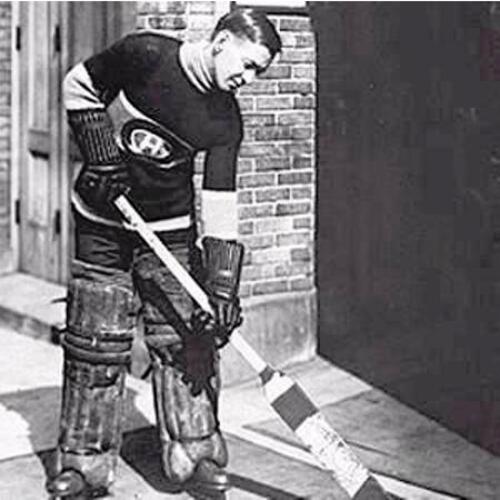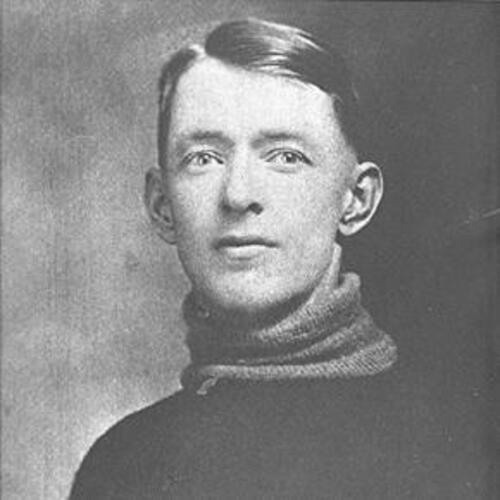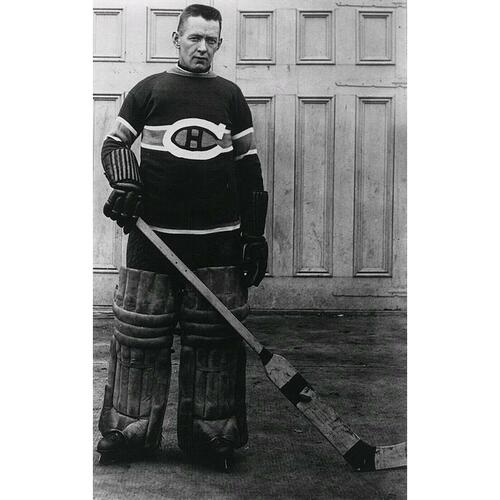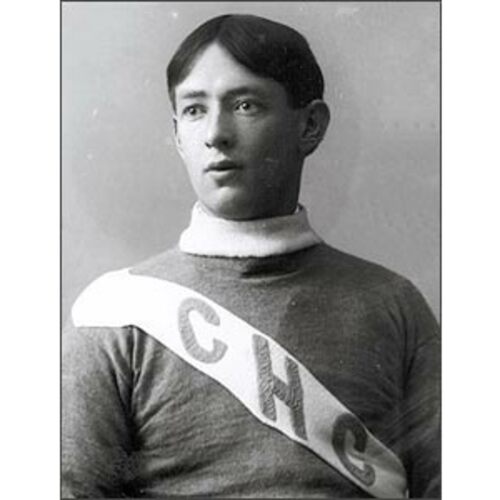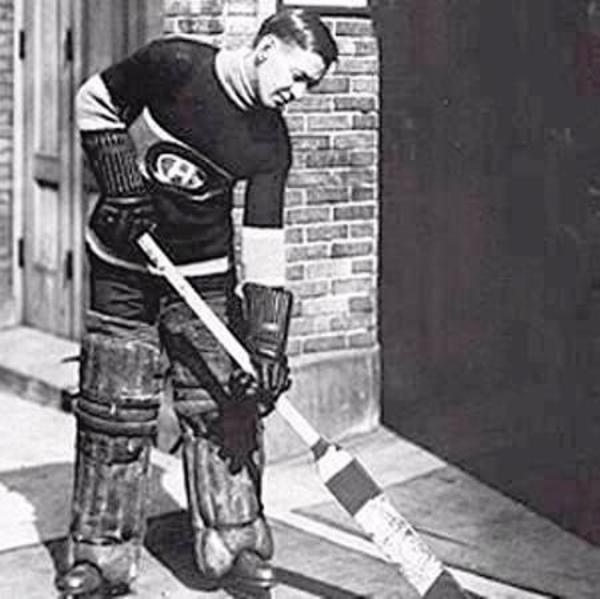
Source: Courtesy of Wikimedia Commons
VÉZINA, GEORGES (baptized Joseph-Georges-Gonzague), professional hockey player; b. 21 Jan. 1887 in Chicoutimi, Que., son of Georges Vézina, a baker, and Clara Belley; m. there 3 June 1908 Marie-Adélaïde-Stella Morin, and they had two sons; d. there 27 March 1926.
Georges Vézina studied at the Petit Séminaire de Chicoutimi from 1898 to 1902, leaving after the second year of the commercial course to help his father in his bakery. At the age of 16 he was taken on as goaltender by the Club de Hockey de Chicoutimi. He was familiar with the game, having played street hockey with his friends, but he had never worn skates. Vézina learned quickly. During the 1904–5 season, at an exhibition game between the Montreal Nationals of the Canadian Amateur Hockey League and the Chicoutimi club – a game Vézina’s team won – the Nationals’ goaltender, Joseph Cattarinich, was impressed by the 18-year-old in the opposing goal. At the end of the 1909–10 season, since he was giving up his position as goaltender for the Canadiens (a club formed in December 1909) to take on other duties with the team, he suggested that Vézina be contacted. To ensure that he would agree to come to Montreal, one of his brothers, who played forward, was also asked to come and practise with the Canadiens for the 1910–11 season. Georges stayed on; his brother went back to Chicoutimi. Hired in December 1910, at a salary of $800 per season (not an unusual figure, since most payers received $1,000 or less in those years), he began a brilliant career with the Montreal Canadiens, in both the National Hockey Association of Canada (1911–17) and the National Hockey League (1918–25).
The Canadiens, who were known as the Club Athlétique Canadien from November 1910 to the end of the 1915–16 season, were not immediately successful but they continued to make progress, with Vézina invariably in the net. At the end of that season they were NHA champions, and they had to face the Portland Rosebuds of the Pacific Coast Hockey Association in the Stanley Cup playoffs. The Canadiens won them in five games. It would be the first of 24 Stanley Cup victories for the Montreal team up to 1998. One of Vézina’s sons was born during the playoffs and he was named Marcel-Stanley in honour of the victory. The following year the Canadiens again won the NHA championship, but in the Stanley Cup playoffs they lost to the Seattle Metropolitans in four games. The same two teams met again in 1919, but the playoffs could not be completed because many players had come down with Spanish influenza. Joseph Henry (Joe) Hall, a defenceman for the Canadiens, succumbed to it on 5 April, as did the Canadiens’ owner, George Washington Kendall, known as George Kennedy, on 19 Oct. 1921. The Canadiens resumed their march to victory in 1924, when three teams were competing for the championship. The Canadiens had to play the Calgary Tigers, and then the Vancouver Maroons, to win the Stanley Cup.
The Canadiens began the 1925–26 season with a home game on 28 November against the Pittsburgh Pirates, a new NHL team. At the beginning of the second period, Vézina collapsed on the ice at the Mount Royal arena. He never returned to his team’s net. At Chicoutimi, during the night of 26 March 1926, with his family gathered around him, he died of tuberculosis. He was 39 years old.
The most notable feature of Vézina’s career was his stamina. From 1911 to 1925 he did not miss a single game for the Montreal Canadiens, and this at a time when teams had only one goaltender in uniform. He played, on average, 21 games during regular seasons, as well as all his team’s exhibition games. In 1917 he even competed against the Canadiens in a friendly match to raise money for the war effort; he played on a soldiers’ team in order to make the competition more even.
Until the 1920s hockey was played according to the rules of rugby, no forward passes being allowed. The slapshot was still unknown. The goaltender could not make all the moves permitted today. He was not allowed to fall onto the ice to stop the puck, or catch it in his hand, or simply immobilize it. All he could do was hold his stick in both hands and use his body and stick to stop the puck and make it bounce back out of the reach of opposing players. These rules explain why Vézina’s career goals-against average – 3.49 – was so high. He was, in fact, one of the best goaltenders in the NHL. Nicknamed “the Chicoutimi Cucumber,” he was famous for his composure in the net.
After Vézina’s death, the Canadiens’ owners, Léo Dandurand, Louis Létourneau, and Joseph Cattarinich, presented a trophy to the NHL in his honour, to be awarded each season to the best goaltender. It was given for the first time in 1927 to George Hainsworth, who had replaced Vézina in the net for the Canadiens. It was subsequently won by other Canadiens goaltenders, including William Ronald Durnan (six times) and Jacques Plante (seven times). Vézina was inducted into the Hockey Hall of Fame in 1945.
ANQ-SLSJ, CE201-S2, 22 janv. 1887. La Patrie, 16 mars 1926. La Presse, 27, 30 mars 1926. Le Progrès du Saguenay (Chicoutimi, Qué.), 30 mars 1926. Dan Diamond and Joseph Romain, The Hockey Hall of Fame; the official history of the game and its greatest stars (Toronto, 1988). D’Arcy Jenish, The Stanley Cup: a hundred years of hockey at its best (Toronto, 1992). Michael McKinley, Hockey Hall of Fame legends: the official book (Toronto, 1993). Charles Mayer, L’épopée des Canadiens de Georges Vézina à Maurice Richard: 46 ans d’histoire, 1909–1955 (Montréal, 1956). Claude Mouton, The Montreal Canadiens: an illustrated history of a hockey dynasty (Toronto, 1987). Andy O’Brien, Les Canadiens: the story of the Montreal Canadiens (Montreal, 1972). Séminaire de Chicoutimi, Annuaire, 1898–1902. Total hockey: the official encyclopedia of the National Hockey League, ed. Dan Diamond et al. (New York, 1998).
Cite This Article
Michel Vigneault, “VÉZINA, GEORGES (baptized Joseph-Georges-Gonzague),” in Dictionary of Canadian Biography, vol. 15, University of Toronto/Université Laval, 2003–, accessed December 12, 2025, https://www.biographi.ca/en/bio/vezina_georges_15E.html.
The citation above shows the format for footnotes and endnotes according to the Chicago manual of style (16th edition). Information to be used in other citation formats:
| Permalink: | https://www.biographi.ca/en/bio/vezina_georges_15E.html |
| Author of Article: | Michel Vigneault |
| Title of Article: | VÉZINA, GEORGES (baptized Joseph-Georges-Gonzague) |
| Publication Name: | Dictionary of Canadian Biography, vol. 15 |
| Publisher: | University of Toronto/Université Laval |
| Year of publication: | 2005 |
| Year of revision: | 2005 |
| Access Date: | December 12, 2025 |


